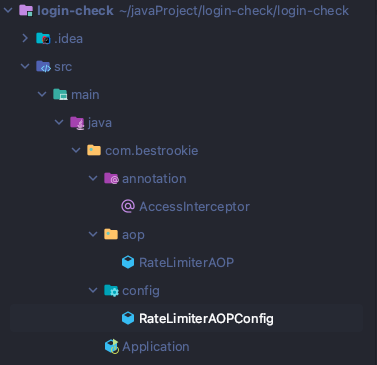1
2
3
4
5
6
7
8
9
10
11
12
13
14
15
16
17
18
19
20
21
22
23
24
25
26
27
28
29
30
31
32
33
34
35
36
37
38
39
40
41
42
43
44
45
46
47
48
49
50
51
52
53
54
55
56
57
58
59
60
61
62
63
64
65
66
67
68
69
70
71
72
73
74
75
76
77
78
79
80
81
82
83
84
85
86
87
88
89
90
91
92
93
94
95
96
97
98
99
100
101
102
103
104
105
106
107
108
109
110
111
112
113
114
115
116
117
118
119
120
121
122
123
124
125
126
127
128
129
130
131
132
133
134
135
136
137
138
139
140
141
142
|
@Slf4j
@Aspect
public class RateLimiterAOP {
private final Cache<String, RateLimiter> loginRecord = CacheBuilder.newBuilder().
expireAfterWrite(1, TimeUnit.MINUTES).
build();
private final Cache<String, Long> blackList = CacheBuilder.newBuilder()
.expireAfterWrite(24, TimeUnit.HOURS)
.build();
@Pointcut("@annotation(com.bestrookie.annotation.AccessInterceptor)")
public void aopPoint(){
}
@Around("aopPoint() && @annotation(accessInterceptor)")
public Object doRouter(ProceedingJoinPoint jp, AccessInterceptor accessInterceptor) throws Throwable{
String key = accessInterceptor.key();
if (StringUtils.isBlank(key)){
throw new RuntimeException("annotation RateLimiter uId is null");
}
String keyAttr = getAttrValue(key, jp.getArgs());
log.info("aop attr {}", keyAttr);
if (!"all".equals(keyAttr) && accessInterceptor.blacklistCount() != 0
&& null != blackList.getIfPresent(keyAttr) &&
blackList.getIfPresent(keyAttr) > accessInterceptor.blacklistCount()){
log.info("限流-黑名单拦截 24h:{}",keyAttr);
return fallbackMethodResult(jp, accessInterceptor.fallbackMethod());
}
RateLimiter rateLimiter = loginRecord.getIfPresent(keyAttr);
if (null == rateLimiter){
rateLimiter = RateLimiter.create(accessInterceptor.permitsPerSecond());
loginRecord.put(keyAttr, rateLimiter);
}
if (!rateLimiter.tryAcquire()){
if (accessInterceptor.blacklistCount() != 0){
if (null == blackList.getIfPresent(keyAttr)){
blackList.put(keyAttr, 1L);
}else {
blackList.put(keyAttr, blackList.getIfPresent(keyAttr) + 1L);
}
}
log.info("限流-超频次拦截:{}", keyAttr);
return fallbackMethodResult(jp, accessInterceptor.fallbackMethod());
}
return jp.proceed();
}
private Object fallbackMethodResult(JoinPoint jp, String fallbackMethod) throws NoSuchMethodException, InvocationTargetException, IllegalAccessException {
Signature sig = jp.getSignature();
MethodSignature methodSignature = (MethodSignature) sig;
Method method = jp.getTarget().getClass().getMethod(fallbackMethod, methodSignature.getParameterTypes());
return method.invoke(jp.getThis(), jp.getArgs());
}
private Method getMethod(JoinPoint jp) throws NoSuchMethodException {
Signature sig = jp.getSignature();
MethodSignature methodSignature = (MethodSignature) sig;
return jp.getTarget().getClass().getMethod(methodSignature.getName(), methodSignature.getParameterTypes());
}
public String getAttrValue(String attr, Object[] args){
if (args[0] instanceof String){
return args[0].toString();
}
String filedValue = null;
for (Object arg : args) {
try {
if (StringUtils.isNotBlank(filedValue)){
break;
}
filedValue = String.valueOf(this.getValueByName(arg, attr));
}catch (Exception e){
log.error("获取路由属性值失败 attr:{}", attr,e);
}
}
return filedValue;
}
private Object getValueByName(Object item, String name){
try {
Field field = getFieldByName(item, name);
if (field == null){
return null;
}
field.setAccessible(true);
Object o = field.get(item);
field.setAccessible(false);
return o;
}catch (IllegalAccessException e){
return null;
}
}
private Field getFieldByName(Object item, String name){
try {
Field field;
try {
field = item.getClass().getDeclaredField(name);
}catch (NoSuchFieldException e){
field = item.getClass().getSuperclass().getDeclaredField(name);
}
return field;
} catch (NoSuchFieldException e){
return null;
}
}
}
|





